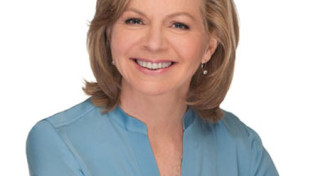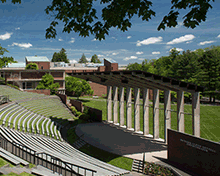A Playwright’s Perspective on Wendy Wasserstein
Like many women in theatre who came of age in the 1980s, I looked to the playwright Wendy Wasserstein ’71 as my lodestar. She was a successful, widely produced theatre artist who talked frankly about sex and relationships (or the lack thereof ). She wrote about feminism, the female body, and a future in which women decide the course of their lives. Before Wasserstein, you didn’t see that on Broadway. Pioneering female playwrights preceded her, but none had achieved Wasserstein’s mainstream visibility. None won Pulitzer Prizes and Tony Awards for blockbuster, commercial hits that dared to show contemporary women’s lives in all their real-world complexity—and make audiences laugh until it hurt while doing it. Wasserstein’s light shone for me and for countless playwrights and directors, women and men, throughout her life and career. When the front page of the New York Times announced her death in 2006, tributes poured in from across the country, and the lights of Broadway dimmed in her honor. Five years later—the fortieth anniversary of her graduation from Mount Holyoke—the College began a yearlong celebration of Wasserstein’s work and life. Staff and faculty organized a major exhibition of her papers, mounted student productions of her plays, led seminars on her body of work, and brought speakers to campus that included theatre luminaries and Wasserstein’s biographer. The final event would be a new theatrical piece, The Wendy Chronicles, based on her plays and myriad other writings. I was assigned the task of creating it. Julie Salamon’s biography Wendy and the Lost Boys: the Uncommon Life of Wendy Wasserstein seemed an ideal place to start looking for the secret contours of Wasserstein’s life. She had both a privileged and a difficult childhood, being pushed to succeed and rarely experiencing approval. Too chubby, too sloppy, too disorganized was a constant refrain in her home. Her older siblings glittered with achievements and accolades while Wendy looked on with fascination—and fantasized about being someone else. She wasn’t fashionable like her fur-wearing mother, Lola, and college in the late ’60s did little to improve her sartorial style. But this was a Mount Holyoke woman. Who cares about clothes when you’ve got brains? Well…her marks didn’t show it—Salamon wrote that Wasserstein’s grades at Mount Holyoke were “the worst she’d ever had.” Lola was dismayed by the grades and disappointed to see her daughter’s romantic encounters fizzle. But Wasserstein did have an exceptional gift for friendship. To know Wendy, in her Lanz flannel nightgowns, eating peanut-butter cookies and spinning cast albums from Broadway shows in her dorm room, was to like her. Really like her. And yet friends your own age can’t give you a career. When she graduated from college, Wasserstein had no idea what she wanted to do. Her Mount Holyoke housemother, Camilla Peach—later immortalized in Uncommon Women as the sherry-sipping, no-pantsallowed- at-tea-dear Mrs. Plumm—believed Wasserstein was fated for secretarial school. Her 1969 evaluation sniffed, “Responsibility toward work in hall: poor. Offices held in hall: none. Qualities of leadership: none. Wendy is a problem.” Still mining for her innate talent, Wasserstein applied and was admitted to what she later called the “Yale “School of Trauma.” She formed deep friendships in the drama school but graduated thinking that “a career in frozen yogurt” was the best she would ever do. “I thought she was lightweight, a little sitcom-y…” shrugged the director of the playwriting program, Robert Brustein. No one in her plays fired a pistol, socked someone in the jaw, stripped naked, or howled expletives. Instead, women talked. Just…talked. In her 1990 commencement speech at Mount Holyoke, Wasserstein explained the source of her fierce determination to change the theatrical landscape. Grinning broadly, a tangle of curls escaping from beneath her commencement cap, Wasserstein told the seniors: “I decided I wanted to see an all-women’s curtain call in the basement of the Yale School of Drama. Uncommon Women was performed for the first time [there]…I will never forget when one rather literate and informed theatregoer raised his hand and said, ‘I can’t get into this. It’s about women.’ ‘Well,’ I whispered to a friend, ‘I’ve spent my life getting into Hamlet and Lawrence of Arabia. Why doesn’t he just try it?’ And it was at that time that I understood the extraordinary value of all-women’s schools. I believe I had the confidence to become a playwright because I learned at Mount Holyoke the value of an individual woman’s voice.” That voice—infectious, irreverent, sly, witty, and, at times, painfully sad—was her calling card. It was the way she slipped past the gatekeepers and got herself into the big party, where prizes are handed out and reputations are made. Her voice was also what surprised female audiences used to hearing women in plays speak though a male megaphone. Suddenly, sitting in darkened theaters, they heard themselves. It was easy to imagine her as a kind of spy in the curtains of the female psyche, secretly recording with a tiny microphone disguised as a pen. Wasserstein’s breakthrough plays—Uncommon Women and Others, about her time at Mount Holyoke; Isn’t it Romantic; and her masterful generational portrait, The Heidi Chronicles—offered an alternative to the latest Sam Shepard or another David Mamet: brilliant playwrights, but hardly known for their nuanced portraits of women. For actresses not content to watch from the sidelines, or to play another drug-addicted prostitute or girlfriend sidekick, Wasserstein was not only a breath of fresh air, she was the only air in the room. In the ’90s and beyond, new women playwrights joined the scene, many breaking out of the white, upper-middleclass world depicted so skillfully by Wasserstein. The landscape was changing, and her plays were not always reliable hits. They received mixed reviews and had shorter runs. One of her most ambitious and her only explicitly political play, An American Daughter, received the worst notices of her career. By the early 2000s, younger actors and directors began asking “Wendy who?” I had to brave the question: does her work hold up now? I began with Uncommon Women, waiting for the ring of recognition and the playful kick of wit that would make me laugh all over again. My marathon took me through every play, screenplay, and sketch she wrote, all the way to her final play, Third. A pile of books gathered at my feet, and I was still waiting to laugh. The characters seemed thin. The writing, once so fresh, sounded dated to my 2012 ears. And the unwritten Wendy Chronicles loomed ahead of me. Dutifully, I returned to my tasks: write connecting text and action between scenes. Piece together excerpts from Wasserstein’s plays and snippets from her diaries and letters, speeches, and essays. Try one structure, then another. Associate Professor of Theatre Arts Erika Rundle, the project’s dramaturge, and I spent hours poring over each beat, each moment. For months, I lived with Wasserstein’s voice in my head. Slowly, a new understanding of the writer began to form. First, there was the meticulous craft of her plays—the structure, like a tightly built house, which allowed her dramatic works to stand. It became clear as I lifted, shaped, arranged, and edited the new piece that every word—and piece of music, image, and action—was painstakingly chosen. Each scene built organically to the next, each character served a purpose. Eventually, the one-liners that had annoyed me began to resonate in a different way. There was more to them than just getting a laugh. I began to hear a darkness reverberating below the surface, like the bass notes anchoring a piece of music. How had I missed it? André Bishop at Play-wrights Horizons, Wasserstein’s great friend and one of the first producers to champion her work, once wrote about why he believed in her: “Because she is good and because she is serious.” The paradox of Wasserstein is that beneath the self-deprecating, giggly exterior lay a powerful will and a ferocious drive. This helped her scale the heights of Broadway—and also served to hide her insecurity, a lifelong struggle to reconcile what Salamon calls her “superiority/ inferiority.” She was better than everyone else, and she was also… nothing. Wasserstein seemed to carry a sliver of pain inside her like an embedded needle. The effort she put into constructing a wall of wit around her was both heroic and sad. And it’s the sadness I hear now, a doubt and regret pulsing beneath the bright surface of comedy, which gives her work its power. The jokes lower our defenses. Then she hits us with serious truths, like a martial artist delivering the perfect, graceful blow. But are the “truths” I discovered anew universal? Would young women today respond to Wasserstein as women did a generation ago? The students in Rundle’s seminar had much to say. Bryna Turner ’12 feels that Wasserstein’s characters bear little resemblance to the Mount Holyoke women of today. “We don’t wonder whether we’ll have a job or get married, or if being a woman is a problem,” she says. “Of course we’ll have a job! Mount Holyoke is teaching us that we’ll succeed, not in spite of being women but because of it.” It’s thrilling to see a young woman’s perfect confidence— and deflating to see an icon topple. But as the class progressed, others expressed different opinions. Miriam Cantor-Stone ’12 signed up for Rundle’s seminar because, she says, Wasserstein is not only her inspiration, but also a major reason she applied to Mount Holyoke. Cantor-Stone feels that Wasserstein’s characters grapple with issues similar to those she and her friends confront: what does it mean to be a woman in today’s society? The balancing act between career and family, self and others, freedom and limitations is just as relevant today. On the one hand, we have Michelle and Hillary. On the other, Pussycat Dolls and “America’s Next Top Model.” The discussions were passionate and wide-ranging. Just as in Wasserstein’s time, the students disagree with one another, argue for what they believe in, take issue with others’ opinions—and remain fierce friends. As a finale to Rundle’s seminar that would have delighted Wasserstein, Turner responded to the diversity of opinion by writing her own play, Uncommon Womyn. Catapulting Wasserstein’s 1970s characters into the jangling, electronic present, the play was staged as a “cabaret” show following performances of the original Uncommon Women. Rooke Theatre filled with students Wasserstein would have recognized—laughing, raucous, opinionated, outspoken. Several played major roles in The Wendy Chronicles, rehearsing with director Don Sanders for the opening on commencement weekend. As they portray Wasserstein’s characters at various stages of life—just out of college, and later in their thirties, forties, and beyond—they seem also to be rehearsing for their own future lives. Lives that may include following Wasserstein’s path to create the next work of art to rock the world.
—By Leanna James Blackwell
This article appeared in the summer 2012 issue of the Alumnae Quarterly.
• View video interviews with Wasserstein biographer Julie Salamon, and “uncommon playwrights” Suzan-Lori Parks ’85, Christopher Durang, and Marsha Norman.
July 17, 2012











Thank you for helping Wasserstein find her voice, highlighting her contributions, and continuing the important work you do.